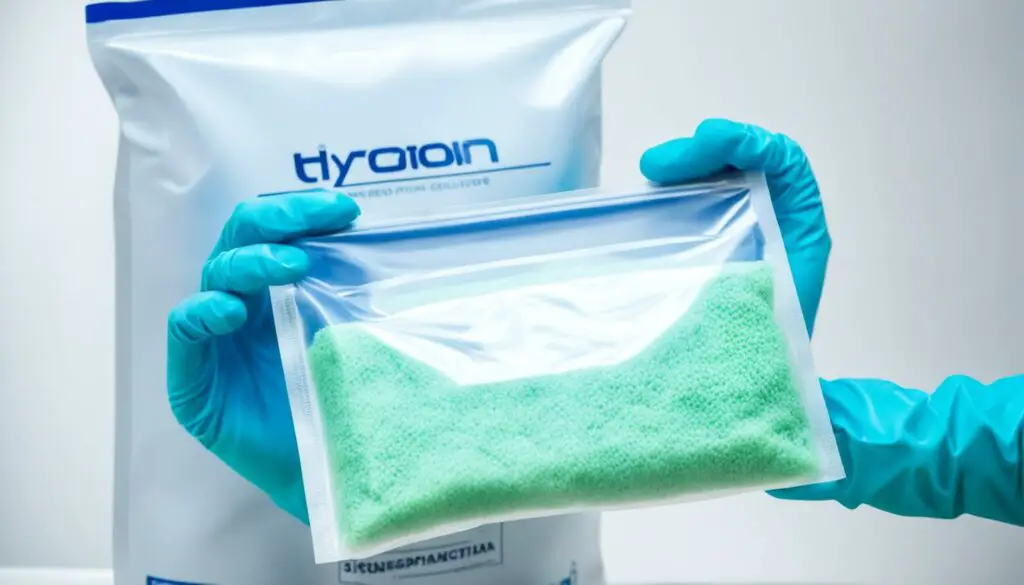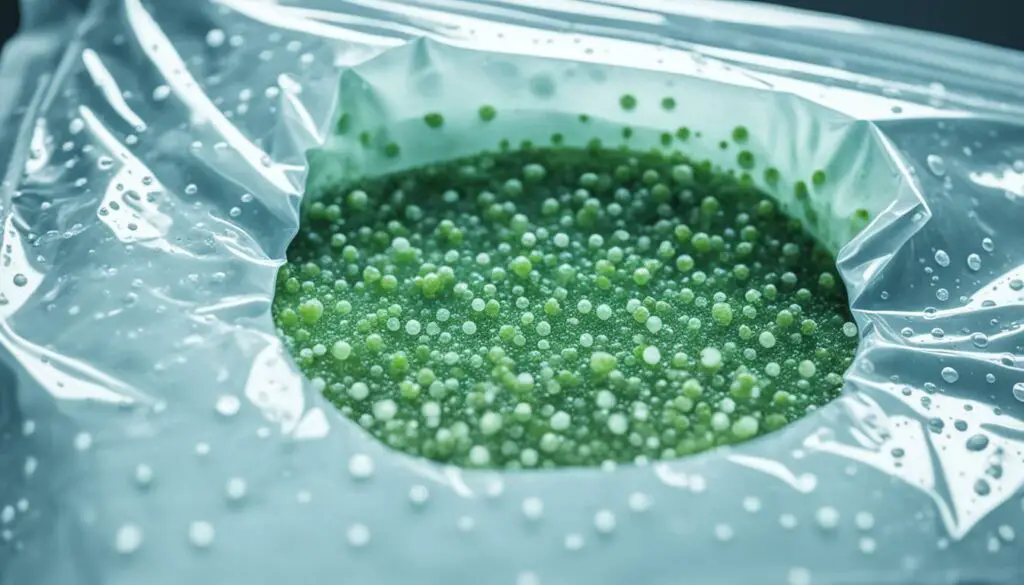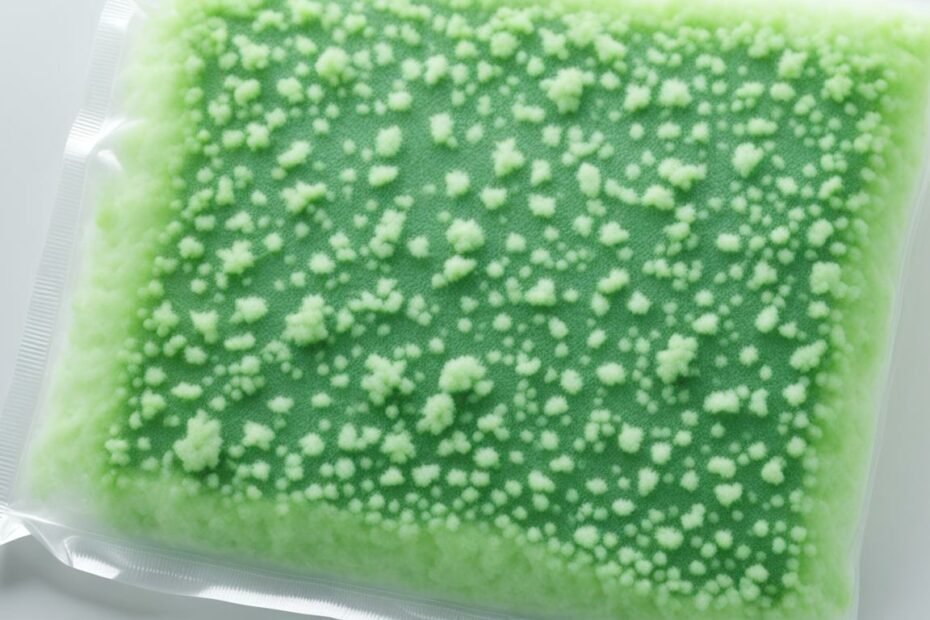Have you ever wondered why mold can show up in sealed bags? Is there a way to stop mold from growing in vacuum-sealed bags? How can you fight off mold to protect your food and items? We’ll look into how mold gets into sealed bags and how to stop it.
Understanding Vacuum Seal Mold Growth
Many people worry about mold growing in sealed bags. Knowing how mold grows in sealed places is key to stopping it.
Moisture is a big reason for mold in sealed bags. Mold needs moisture to live. If there’s even a little bit of wetness in the bag, that’s enough for mold over time.
The kind of material in the bag matters too. Some materials fight mold better. Choose bags made from materials that stop mold.
Knowing these things helps avoid mold in sealed bags. Keep moisture low and pick the right bag material to fight mold. This keeps your stuff safe for longer.
To see why understanding mold growth in sealed bags is crucial, check out the diagram below:
| Factors | Description |
|---|---|
| Moisture | Moisture inside the bag supports mold growth. |
| Materials | The materials in the bags can stop or help mold grow. |
The diagram offers a clear view of why mold grows in sealed bags. It shows how to stop mold and keep your things fresh.
The Battle Against Mold Development in Sealed Containers
Why Moisture is the Enemy
Moisture is a big player in mold growth. It’s the top issue when trying to stop mold in vacuum sealed bags. Mold loves to grow where there’s moisture. And just a bit can make a perfect place for it to start. So, it’s vital to keep things dry when using vacuum-sealed bags.
To stop mold, you gotta control the moisture inside sealed bags. Wet food or condensation can sneak in and cause problems. Always make sure items are dry before you seal them. Also, keep sealed bags in a place that’s cool and not too humid. This cuts down on the risk of mold.
Material and Mold Growth
The material of vacuum sealer bags matters too. Some materials might let mold grow more easily. Bags that are poorly made or not for sealing might not keep moisture or mold out well.
Buying good bags that are meant to block mold is a smart move. These bags keep moisture and spores out. Your sealed items will stay mold-free for a long time. Choosing the right bags means less worry about mold.

Know that moisture and bag material are key in preventing mold. Keep things dry, use the best bags, and mold won’t stand a chance. You can safely use vacuum sealing without fearing mold.
Preventing Mold in Vacuum Sealed Bags
Proper Storage Techniques
Store your items the right way to prevent mold in vacuum sealed bags. Here’s what you should do:
- Ensure that the items being sealed are completely dry before vacuum sealing them. Any moisture present can create an environment for mold to develop.
- Remove as much air as possible from the bag to minimize the oxygen available for mold growth. This can be done using a vacuum sealer machine.
- Store the vacuum sealed bags in a cool, dry, and dark place. Avoid areas with high humidity or temperature fluctuations.
- Avoid overpacking the bags. This could cause air pockets. Air pockets might lead to moisture and mold, so, it’s best to avoid them.
Importance of a Quality Vacuum Sealer
Choosing a good vacuum sealer is crucial for stopping mold. A top-notch sealer will make sure no air or moisture can get in. It should have strong suction, options for sealing, and be built to last. Such a sealer is a key part of keeping your food fresh and safe.
Cleaning Procedures before Sealing
Before sealing your items, be careful with cleaning. Here’s how to keep them mold-free:
- Thoroughly clean the items you wish to seal. Remove any dirt, food residue, or moisture from the surfaces.
- Let the items dry completely before placing them in the vacuum sealer bags. Any residual moisture can contribute to mold growth inside the sealed bags.
- Regularly clean and maintain your vacuum sealer by the book. This keeps bacteria and mold away and makes sure it works well.
Use these techniques, pick a great vacuum sealer, and clean properly before sealing. This way, you’ll protect your stuff from mold.
Can mold grow in a vacuum sealed bag?
Many wonder if mold can still grow in a vacuum sealed bag. People use vacuum sealing to keep their food and items safe. The big question is, does it really protect against mold?
To figure out if mold can grow in a vacuum sealed bag, we need to know what mold needs. Mold needs moisture, things to feed on, and the right temperature. Even in a sealed bag, if these conditions are right, mold can grow.
Moisture is a key player in mold growth. Any moisture inside the bag when you seal it can cause mold. Make sure everything inside is dry. This stops mold from getting a start.
Having organic material in the bag also helps mold grow. Make sure to clean items before sealing them. This removes possible food for mold.
Temperature is important too. Mold likes warm and damp places. Even sealed, the bag’s inside can get warm. If it’s humid, mold could find a nice home.
Vacuum sealing does a lot to stop mold, but it’s not full-proof. To lower the risk more, make sure everything is dry and clean. Store them in a cool, dry spot too.

Vacuum Sealing and Mold Control: Myths and Facts
Mold in vacuum sealed bags has caused many myths about airtight storage. We will clear up these myths and talk about how mold can grow despite sealing.
Myths About Mold and Airtight Storage
- Myth 1: People think vacuum sealing removes all moisture, stopping mold.
- Myth 2: Some believe combining vacuum sealing with airtight containers prevents mold.
- Myth 3: There’s the mistaken idea that sealing something means it’s safe from mold.
Believing in these myths can make us think we’re safe from mold in sealed bags. Although vacuum sealing helps keep food fresh and items safe, it’s not perfect against mold.
The Facts: Why Mold Can Still Form
Even with vacuum sealing, mold can still show up. Here’s why:
- Moisture: Sealing removes some moisture, not all. If food or the container is wet before sealing, mold finds a home.
- Air Circulation: Vacuum sealed bags are airtight but can’t stop all air movement. This lets mold spores in, encouraging mold growth.
- Contamination: Sealing items with mold spores lets the mold win. Make sure everything is clean and mold-free first.
Knowing these facts is crucial. It helps in taking steps to prevent mold, even with vacuum sealing.
Mold Formation in Vacuum Packed Bags: Real-life Experiences
In this section, we look at real-life stories about mold in vacuum sealed bags. People share challenges and solutions they found. You’ll learn how to handle mold in your own bags from these experiences.
Personal Accounts of Mold Growth
Now, let’s listen to those who found mold in their vacuum sealed bags. They share how hard it was and what they learned. Their stories teach us how to prevent and deal with mold in our bags too.
Steps Taken by Home Cheesemakers
People making cheese at home face a special mold challenge. They have tricks to keep their cheese free of mold. Their methods offer good tips on stopping mold, which apply to other foods and stuff too.
By understanding these stories and the cheese-makers’ tips, you gain useful knowledge. You’ll know how to keep your vacuum packed bags mold-free.
Conclusion
Mold in vacuum sealer bags is a common issue. With the right info and steps, it’s manageable. We’ve discussed mold growth causes, how to stop it, and shared real stories. This gives you insights for handling mold in your bags.
To stop mold, follow the steps in this article. Keep your items dry. Use quality bags that resist mold. This will lower the chance of mold and keep your bags clean.
Moisture is a big factor in mold growth. Pick bags that prevent mold. With these steps, you’ll protect your items from mold in your sealed bags.
Using this guide, you can prevent mold in your vacuum sealer bags. Always aim for safe storage. With the right steps, keep your bags free of mold. Your food and items will stay fresh longer.
